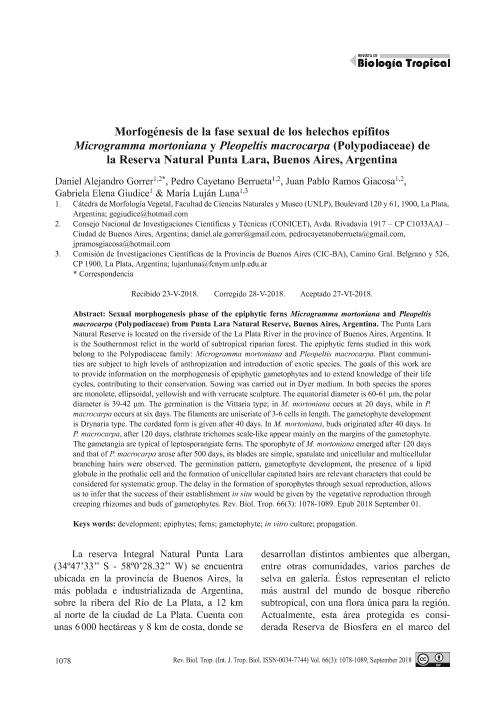Mostrar el registro sencillo del ítem
dc.contributor.author
Gorrer, Daniel Alejandro

dc.contributor.author
Berrueta, Pedro Cayetano

dc.contributor.author
Ramos Giacosa, Juan Pablo

dc.contributor.author
Giudice, G. E.
dc.contributor.author
Luna, M. L.
dc.date.available
2019-10-18T13:13:45Z
dc.date.issued
2018-09
dc.identifier.citation
Gorrer, Daniel Alejandro; Berrueta, Pedro Cayetano; Ramos Giacosa, Juan Pablo; Giudice, G. E.; Luna, M. L.; Morfogénesis de la fase sexual de los helechos epífitos Microgramma mortoniana y Pleopeltis macrocarpa (Polypodiaceae) de la Reserva Natural Punta Lara, Buenos Aires, Argentina; Revista de Biología Tropical; Revista de Biología Tropical; 66; 9-2018; 1078-1089
dc.identifier.issn
0034-7744
dc.identifier.uri
http://hdl.handle.net/11336/86290
dc.description.abstract
Sexual morphogenesis phase of the epiphytic ferns Microgramma mortoniana and Pleopeltis macrocarpa (Polypodiaceae) from Punta Lara Natural Reserve, Buenos Aires, Argentina. The Punta LaraNatural Reserve is located on the riverside of the La Plata River in the province of Buenos Aires, Argentina. Itis the Southernmost relict in the world of subtropical riparian forest. The epiphytic ferns studied in this workbelong to the Polypodiaceae family: Microgramma mortoniana and Pleopeltis macrocarpa. Plant communitiesare subject to high levels of anthropization and introduction of exotic species. The goals of this work areto provide information on the morphogenesis of epiphytic gametophytes and to extend knowledge of their lifecycles, contributing to their conservation. Sowing was carried out in Dyer medium. In both species the sporesare monolete, ellipsoidal, yellowish and with verrucate sculpture. The equatorial diameter is 60-61 μm, the polardiameter is 39-42 μm. The germination is the Vittaria type; in M. mortoniana occurs at 20 days, while in P.macrocarpa occurs at six days. The filaments are uniseriate of 3-6 cells in length. The gametophyte development is Drynaria type. The cordated form is given after 40 days. In M. mortoniana, buds originated after 40 days. In P. macrocarpa, after 120 days, clathrate trichomes scale-like appear mainly on the margins of the gametophyte. The gametangia are typical of leptosporangiate ferns. The sporophyte of M. mortoniana emerged after 120 days and that of P. macrocarpa arose after 500 days, its blades are simple, spatulate and unicellular and multicellular branching hairs were observed. The germination pattern, gametophyte development, the presence of a lipid globule in the prothalic cell and the formation of unicellular capitated hairs are relevant characters that could be considered for systematic group. The delay in the formation of sporophytes through sexual reproduction, allows us to infer that the success of their establishment in situ would be given by the vegetative reproduction through creeping rhizomes and buds of gametophytes
dc.format
application/pdf
dc.language.iso
spa
dc.publisher
Revista de Biología Tropical

dc.rights
info:eu-repo/semantics/openAccess
dc.rights.uri
https://creativecommons.org/licenses/by-nc-sa/2.5/ar/
dc.subject
Development
dc.subject
Epyphytes
dc.subject
Ferns
dc.subject
Gametophyte
dc.subject
In vitro culture
dc.subject
Propagation
dc.subject.classification
Ciencias de las Plantas, Botánica

dc.subject.classification
Ciencias Biológicas

dc.subject.classification
CIENCIAS NATURALES Y EXACTAS

dc.subject.classification
Conservación de la Biodiversidad

dc.subject.classification
Ciencias Biológicas

dc.subject.classification
CIENCIAS NATURALES Y EXACTAS

dc.title
Morfogénesis de la fase sexual de los helechos epífitos Microgramma mortoniana y Pleopeltis macrocarpa (Polypodiaceae) de la Reserva Natural Punta Lara, Buenos Aires, Argentina
dc.title
Morphogenesis of the sexual phase of the epiphytic ferns Microgramma mortoniana and Pleopeltis macrocarpa (Polypodiaceae) Punta Lara Natural Reserve, Buenos Aires, Argentina
dc.type
info:eu-repo/semantics/article
dc.type
info:ar-repo/semantics/artículo
dc.type
info:eu-repo/semantics/publishedVersion
dc.date.updated
2019-09-27T14:31:35Z
dc.journal.volume
66
dc.journal.pagination
1078-1089
dc.journal.pais
Costa Rica

dc.journal.ciudad
Turrialba
dc.description.fil
Fil: Gorrer, Daniel Alejandro. Universidad Nacional de La Plata. Facultad de Ciencias Naturales y Museo. Cátedra de Morfología Vegetal; Argentina
dc.description.fil
Fil: Berrueta, Pedro Cayetano. Universidad Nacional de La Plata. Facultad de Ciencias Naturales y Museo. Cátedra de Morfología Vegetal; Argentina
dc.description.fil
Fil: Ramos Giacosa, Juan Pablo. Universidad Nacional de La Plata. Facultad de Ciencias Naturales y Museo. Cátedra de Morfología Vegetal; Argentina
dc.description.fil
Fil: Giudice, G. E.. Universidad Nacional de La Plata. Facultad de Ciencias Naturales y Museo. Cátedra de Morfología Vegetal; Argentina
dc.description.fil
Fil: Luna, M. L.. Universidad Nacional de La Plata. Facultad de Ciencias Naturales y Museo. Cátedra de Morfología Vegetal; Argentina
dc.journal.title
Revista de Biología Tropical

dc.relation.alternativeid
info:eu-repo/semantics/altIdentifier/doi/https://doi.org/10.15517/rbt.v66i3.31775
dc.relation.alternativeid
info:eu-repo/semantics/altIdentifier/url/https://revistas.ucr.ac.cr/index.php/rbt/article/view/31775
Archivos asociados
